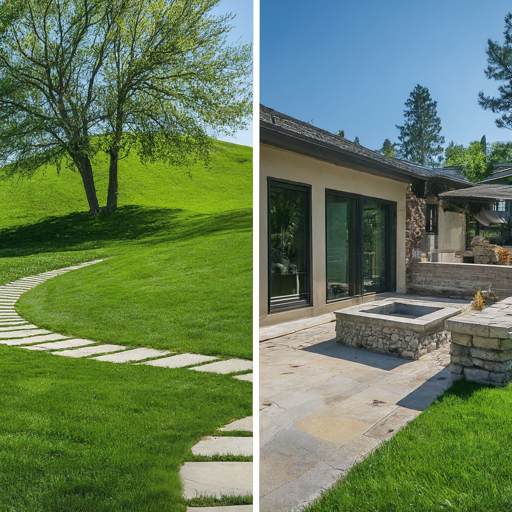
If you are looking for ways to improve your outdoor space, you may have come across the terms hardscape design and landscape design. These are two different types of design that can enhance the appearance and functionality of your yard or garden. But what exactly are they and how do they differ? And more importantly, how can you choose the best option for your outdoor space?
In this blog post, we will explain the differences between hardscape design and landscape design, as well as the pros and cons of each. We will also give you some tips on how to choose the best option for your outdoor space based on your needs, preferences, and budget.
What is Hardscape Design?
Hardscape design is the use of non-living materials, such as concrete, stone, brick, wood, metal, or gravel, to create features and structures in your outdoor space. Some examples of hardscape design are:
- Patios
- Walkways
- Driveways
- Decks
- Fences
- Retaining walls
- Fire pits
- Water features
Hardscape design can provide many benefits for your outdoor space, such as:
- Creating flat and level surfaces for walking, sitting, and placing furniture
- Defining and separating different areas of your outdoor space
- Adding visual interest and contrast to your outdoor space
- Increasing the value and curb appeal of your property
- Providing durability and low maintenance
However, hardscape design also has some drawbacks, such as:
- Increasing the cost and complexity of your outdoor project
- Raising your property taxes due to the addition of permanent structures
- Reducing the permeability and drainage of your soil
- Creating heat islands and increasing the temperature of your outdoor space
- Impacting the environment and wildlife habitats
What is Landscape Design?
Landscape design is the use of living materials, such as plants, flowers, grass, trees, shrubs, or mulch, to create a natural and organic look for your outdoor space. Some examples of landscape design are:
- Lawns
- Garden beds
- Flower pots
- Vegetable gardens
- Herb gardens
- Rock gardens
- Xeriscapes
- Rain gardens
Landscape design can provide many benefits for your outdoor space, such as:
- Creating a beautiful and colorful look for your outdoor space
- Providing shade, privacy, and noise reduction for your outdoor space
- Improving the air quality and oxygen levels of your outdoor space
- Attracting birds, butterflies, and other beneficial insects to your outdoor space
- Reducing soil erosion and water runoff from your outdoor space
However, landscape design also has some drawbacks, such as:
- Requiring regular and seasonal maintenance, such as watering, pruning, weeding, and fertilizing
- Increasing the risk of pests, diseases, and allergies in your outdoor space
- Consuming more water and resources than hardscape design
- Changing and evolving over time, which may affect your desired look and design
- Depending on the climate and soil conditions of your outdoor space
How to Choose the Best Option for Your Outdoor Space?
There is no definitive answer to which option is better for your outdoor space, as it depends on various factors, such as:
- The size and shape of your outdoor space
- The purpose and function of your outdoor space
- The style and theme of your outdoor space
- The budget and time frame of your outdoor project
- The climate and soil conditions of your outdoor space
- Your personal preferences and tastes
However, here are some general tips on how to choose the best option for your outdoor space:
- Consider the balance and harmony of your outdoor space. A good rule of thumb is to have a 70/30 ratio of landscape to hardscape, or vice versa, depending on your preference. This will ensure that your outdoor space is not too crowded or too sparse, and that it has a cohesive and pleasing look.
- Consider the contrast and variety of your outdoor space. A good way to add contrast and variety to your outdoor space is to mix and match different materials, colors, textures, and shapes of hardscape and landscape elements. This will create visual interest and diversity in your outdoor space and prevent it from being boring or monotonous.
- Consider the functionality and usability of your outdoor space. A good way to ensure that your outdoor space is functional and usable is to plan ahead and think about how you want to use your outdoor space. For example, if you want to use your outdoor space for entertaining guests, you may want to have a patio, a fire pit, and some seating areas. If you want to use your outdoor space for gardening, you may want to have a vegetable garden, a herb garden, and some flower pots.
Conclusion
Hardscape design and landscape design are two different types of design that can enhance your outdoor space. Both have their pros and cons, and the best option for your outdoor space depends on various factors. By following the tips above, you can choose the best option for your outdoor space and create a beautiful and functional outdoor space that suits your needs and preferences.
If you need professional help with hardscape design and installation or landscape design and installation, you can contact us at Hardscape Service or Landscape Design Service. We are a team of experts who can provide you with quality hardscape and landscape services at affordable prices. We can help you transform your outdoor space into your dream outdoor space. Contact us today for a free consultation and estimate.


